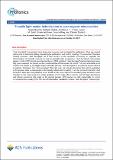Files in this item
Tunable light-matter hybridization in open organic microcavities
Item metadata
| dc.contributor.author | Betzold, Simon | |
| dc.contributor.author | Herbst, Stefanie | |
| dc.contributor.author | Trichet, Aurélien A. P. | |
| dc.contributor.author | Smith, Jason M. | |
| dc.contributor.author | Würthner, Frank | |
| dc.contributor.author | Höfling, Sven | |
| dc.contributor.author | Dietrich, Christof | |
| dc.date.accessioned | 2018-10-10T23:48:40Z | |
| dc.date.available | 2018-10-10T23:48:40Z | |
| dc.date.issued | 2018-01-17 | |
| dc.identifier | 251360842 | |
| dc.identifier | aa256cfc-92e4-403a-ae3a-72c737b993c9 | |
| dc.identifier | 85040671333 | |
| dc.identifier | 000423140300009 | |
| dc.identifier.citation | Betzold , S , Herbst , S , Trichet , A A P , Smith , J M , Würthner , F , Höfling , S & Dietrich , C 2018 , ' Tunable light-matter hybridization in open organic microcavities ' , ACS Photonics , vol. 5 , no. 1 , pp. 90-94 . https://doi.org/10.1021/acsphotonics.7b00552 | en |
| dc.identifier.issn | 2330-4022 | |
| dc.identifier.other | RIS: urn:CBF0B7F79249C3559A18FC6DFB9837CA | |
| dc.identifier.uri | https://hdl.handle.net/10023/16185 | |
| dc.description | Sv.H. acknowledges funding by the EPSRC ”Hybrid Polaritonics” Grant (EP/M025330/1), F.W. further thanks the Deutsche Forschungsgemeinschaft (DFG) for financial support (WU317/18-1). J.S. and A.A.P.T. thank the Leverhulme Trust (RPG-2012-526) and the UK Engineering and Physical Sciences Research Council (EP/M013243/1) for financial support. | en |
| dc.description.abstract | Open microcavities represent a versatile cavity design that allows the external control of internal properties such as cavity thickness and mode detuning without changing the key parameters of the cavity itself, rendering them particularly interesting for light-matter interaction experiments. Here, we demonstrate the tunability of an open microcavity with an embedded active organic layer providing parallel alignment of molecular transition dipole moments as well as strong self-absorption inside the cavity. By decreasing the cavity thickness, we observe a transition from the weak coupling regime into the strong coupling regime evidenced by the onset of avoided crossing behavior between involved modes. This change of coupling mechanism is shown for 2D (planar) as well as 0D (hemispherical) cavities. | |
| dc.format.extent | 5 | |
| dc.format.extent | 3441055 | |
| dc.language.iso | eng | |
| dc.relation.ispartof | ACS Photonics | en |
| dc.subject | Open microcavity | en |
| dc.subject | Organic semiconductors | en |
| dc.subject | Exciton-polaritons | en |
| dc.subject | QC Physics | en |
| dc.subject | NDAS | en |
| dc.subject.lcc | QC | en |
| dc.title | Tunable light-matter hybridization in open organic microcavities | en |
| dc.type | Journal article | en |
| dc.contributor.sponsor | EPSRC | en |
| dc.contributor.institution | University of St Andrews. School of Physics and Astronomy | en |
| dc.contributor.institution | University of St Andrews. Condensed Matter Physics | en |
| dc.identifier.doi | https://doi.org/10.1021/acsphotonics.7b00552 | |
| dc.description.status | Peer reviewed | en |
| dc.date.embargoedUntil | 2018-10-11 | |
| dc.identifier.grantnumber | EP/M025330/1 | en |
This item appears in the following Collection(s)
Items in the St Andrews Research Repository are protected by copyright, with all rights reserved, unless otherwise indicated.

